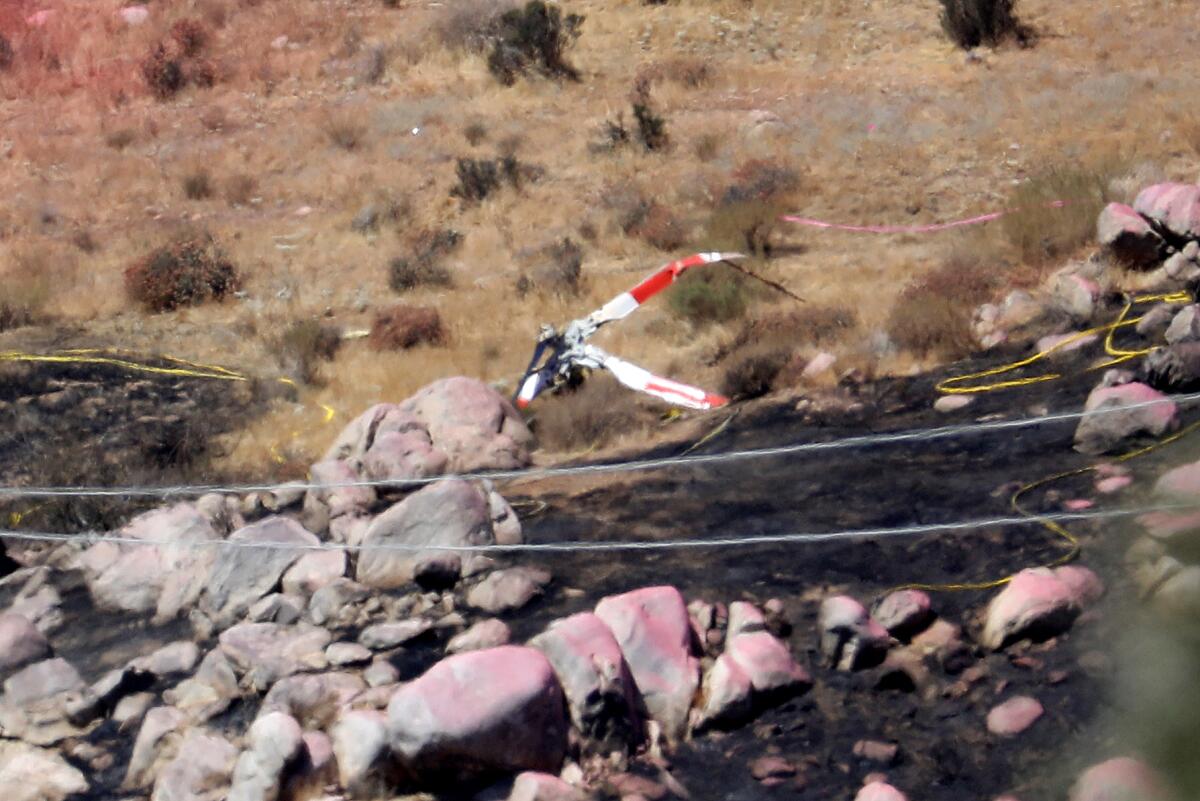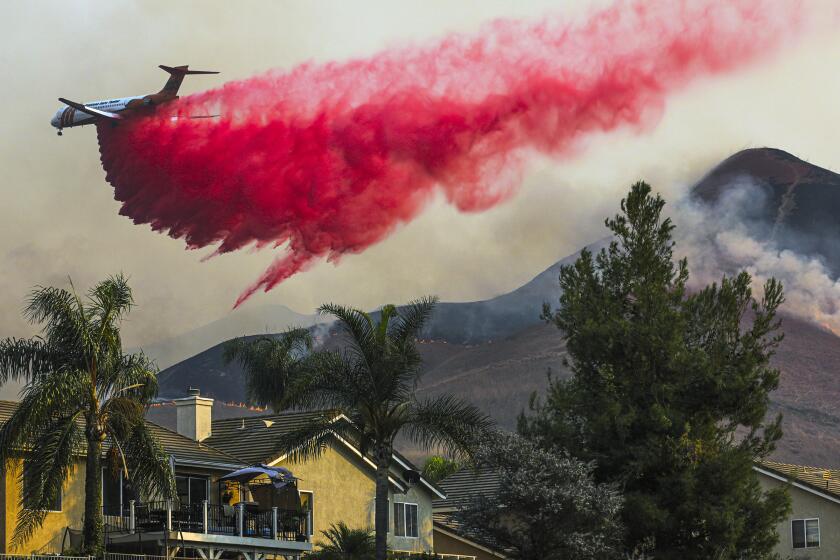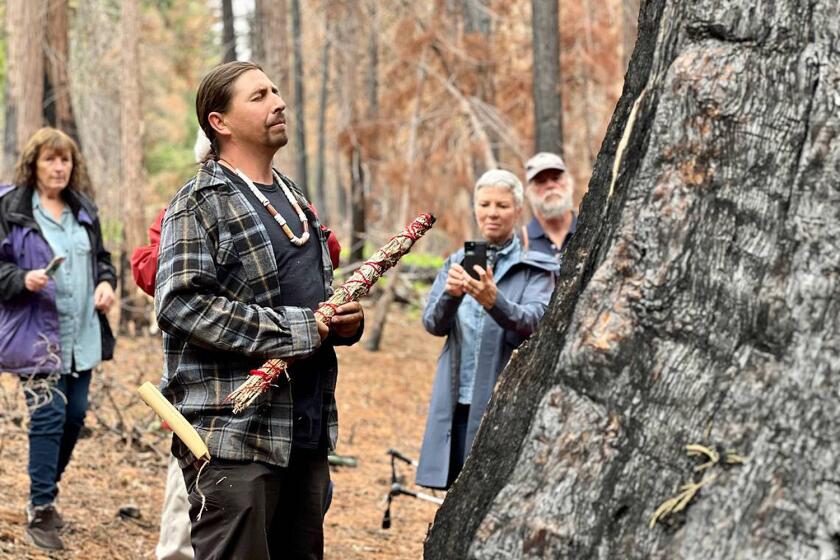Fire helicopter lacked collision-avoidance system before midair crash

- Share via
One of two firefighting helicopters that collided in midair over a Southern California brush fire lacked an electronic warning device that alerts pilots to approaching aircraft — a critical deficiency, according to at least one former wildland fire pilot.
As the National Traffic Safety Board continues to investigate the fatal, Aug. 6 crash of two contract California Department of Forestry and Fire Protection helicopters, a career pilot and advocate for collision avoidance systems is calling attention to the fact that one of the choppers lacked a traffic collision-avoidance system, or TCAS, which audibly alerts pilots when another aircraft is nearby.
“I’m frankly shocked that this is not required on contract helicopters to this day,” said Juan Browne, a former U.S. Forest Service lead plane pilot who now flies Boeing 777s out of Los Angeles for a major airline.
“That’s the one last piece of safety equipment that could have prevented this accident,” he said.
The helicopter crash, which killed three, marks a rare instance in which an aviation battle of a California fire has resulted in a midair collision.
The surveillance systems and accompanying transponders are standard technology on all state-owned Cal Fire aircraft. Also, a Forest Service smokejumpers guide describes TCAS as “an invaluable safety tool” that is “only effective if all aircraft have their transponders operating.”
However, not all aviation experts interviewed by The Times agreed that the system would have averted disaster. At least one said the system was designed for fixed-wing aircraft, and would be less useful for firefighting helicopters.
What experts did agree on though was that the collision points to a loss of situational awareness. The big question, they said, is how that awareness broke down and crew members aboard each helicopter lost track of where the other was located.
For ground crews and commanders working the small brush fire in the Riverside County community of Cabazon, word that something had gone horribly wrong crackled over their radios at 6:48 p.m. — roughly an hour before sunset.
“Midair collision with two of the copters involving 37 Sierra and 5 Alpha Sierra,” a voice said, referring to the aircrafts’ call signs.
Both helicopters had lifted off just minutes apart from Hemet-Ryan Airport — a Cal Fire air attack base some 18 miles from the fire — and swooped through mountain passes before heading into the valley below. They collided less than 15 minutes after takeoff, and were just a couple hundred feet off the ground when the impact occurred, according to data available on flight tracking websites.
One of the choppers — a water-dropping Sikorsky S-64E Skycrane — was able to make a hard landing in a nearby field. Its two occupants walked away.
But the other aircraft — a Bell 407 that had been serving as the mission’s helicopter coordinator — plummeted to the ground, killing Cal Fire Assistant Chief Joshua Bischof, 46; Capt. Tim Rodriguez, 44; and contract pilot Tony Sousa, 55.
The NTSB, which wrapped up its on-scene inquiry Aug. 9, plans to release a preliminary report as soon as Monday. The full investigation is expected to take one to two years.
An NTSB spokesperson said only that the investigation would evaluate all factors in the crash — human, environmental and mechanical. However, experts contacted by The Times said one of the main questions investigators would need to address was why the aircraft failed to recognize each other’s proximity before the crash.
Southern California is notorious for its congested airspace, and the Cabazon fire was no exception.
A total of six aircraft were dispatched to the scene — three airplanes and three helicopters — and the fire was burning close to Banning Municipal Airport, which may have posed a distraction because it’s possible the pilots had to change frequencies to deal with the air traffic, Browne said.
And although the weather was clear, the helicopters converged as the sun was setting behind them, which may have resulted in shadows being cast by the San Jacinto Mountains.
“They merged together at a very acute angle and it’s probably going to turn out to be right in the blind spots of these two helicopters, because of the design, where the pillars are located, the way the cockpit is laid out — all that,” Browne said.
In addition, the Bell was silver, which may have made it more difficult to see. Cal Fire aircraft are painted bright colors, usually red and white.
After using flight tracking data to reconstruct the collision in a video posted to his popular YouTube channel, Browne speculated that the Bell may have contacted the Skycrane’s landing gear, which caused the Bell’s rotor and blades to separate from the rest of the aircraft. Images of the crash site show that the helicopter’s rotor landed some distance away from its fuselage, he added.
Hunt Norris, general manager of Yuba City-based Siller Helicopters, owner-operator of the Skycrane, described the collision as “extremely rare” and said the Skycrane sustained minor damage that was confined to its landing gear.
The York fire, which began in the Mojave National Preserve and spread into Nevada over the weekend, is uncontained.
It remains unclear why the helicopters were flying at the same altitude.
Cal Fire has procedures to ensure that aircraft are in communication with each other and that they maintain proper altitude separation, officials said. Typically, when aircraft are dispatched to a fire, pilots check in with the air tactical group supervisor to learn their responsibilities and altitude assignments before they arrive.
“For whatever reason, there was not an altitude deconfliction in this case, and that’s very unusual,” said Jack Cress, an instructor in helicopter accident investigation at USC. “Cal Fire spends a lot of time choreographing the way that the aircraft are going to be brought into the scene.”
To figure out what went wrong, investigators will look into both the optical visibility of the two helicopters, as well as their electronic visibility — what instrumentation was available on board that could have prevented the collision, he said.
In that regard, there are two key pieces of equipment. One is the Automatic Dependent Surveillance-Broadcast, or ADS-B, in which an aircraft transmits information about its altitude, positioning and speed to air traffic control ground stations and other aircraft that have the equipment installed. All civilian helicopters have this technology, he said.
The other is the traffic collision avoidance system, which audibly alerts pilots when another aircraft is nearby and tells them what evasive action — a turn, climb, or descent — they need to take to avoid it, he said.
While many fire experts say retardant is an invaluable resource for battling blazes, a growing number of environmentalists have raised concerns about the bright pink material.
All commercial jetliners are required to have TCAS installed, but the Federal Aviation Administration does not mandate it for helicopters, said Hassan Shahidi, president and chief executive of the Flight Safety Foundation, an international nonprofit.
And while aircraft owned by Cal Fire are equipped with TCAS, the agency does not require it to be installed on all of its contract aircraft, said Nick Schuler, the agency’s deputy director of communications and emergency incident awareness.
Aircraft and pilots that contract with Cal Fire are required to obtain an interagency qualification card issued by the Forest Service, U.S. Department of the Interior or Cal Fire. Those rules state that TCAS systems are required only on helicopters that are authorized to carry passengers other than the essential flight crew, Schuler said.
The Bell 407, which met this standard, was equipped with TCAS, he said. The Skycrane, which was not authorized to carry nonessential passengers, did not have TCAS, he said.
In order for TCAS to alert one aircraft that another is nearby, both aircraft must have the technology installed and their transponders turned on, Shahidi said.
“I’ve been fighting this lack of TCAS my whole career, and we’ve slowly been getting TCAS implemented into the firefighting command,” Browne said.
When Browne was flying C-141s for the U.S. Air Force many years ago, he lost a co-pilot in a midair collision off the coast of Africa, he said in a YouTube video. Surviving family and colleagues successfully lobbied for TCAS equipment to be installed in Air Force transport aircraft, he said.
Then, when Browne served in the Forest Service lead plane program, he took over the job of a pilot who died in a 1995 midair collision with an air tanker while responding to a fire in Ramona, he said. After more lobbying, TCAS was installed in the agency’s fixed-wing air tankers, he said.
A controlled burn in Calaveras Big Trees State Park has badly damaged a pair of giant sequoias named ‘the Orphans,’ outraging community members.
Although Browne insists that TCAS could have prevented the collision, Shahidi was skeptical.
He said TCAS are geared toward fixed-wing transport airplanes that have set flight paths. The technology would not necessarily be useful in firefighting helicopters that are highly maneuverable and operating at high speeds, low altitudes and in close proximity to one another during an emergency, he said.
“If they were equipped with these alerts, because of the logic of the software, they would be going off all the time in terms of alerts to the pilots to descend or increase their altitudes,” Shahidi said. “And it would actually be counterproductive for the pilot to have that.”
In that type of environment, he said, a centralized command and control entity that is able to manage the tight airspace and ensure that aircraft are in position and aware of each other’s location is key. ADS-B, which provides a visual display but no alerts, would also help make pilots and ground controllers aware of the aircrafts’ location, he added.
“Those are the tools that are going to be important to make sure a tragedy like this does not occur, where there’s a collision because pilots are losing situational awareness of who is in the area and what their proximity is,” he said.
More to Read
Sign up for Essential California
The most important California stories and recommendations in your inbox every morning.
You may occasionally receive promotional content from the Los Angeles Times.

















